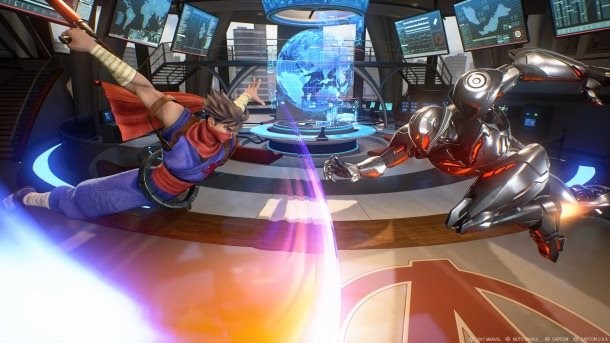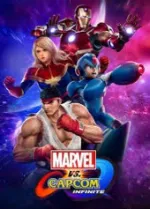Our extra-large special edition is here. Subscribe today and receive the 25% longer issue at no extra cost!
Marvel vs. Capcom: Infinite

I recently had the chance to play Marvel Vs. Capcom: Infinite with Capcom producer Mike Evans and associate producer Peter Rosas. After getting a quick overview of some of the game’s features, I asked Capcom a bunch of nerdy questions about which tricks from previous titles carry over, what the game as whole is, and how older characters have evolved in the six years between Marvel Vs. Capcom 3 and Infinite.
The Basics
1. The currently confirmed playable characters are:
Marvel
• Captain America
• Captain Marvel
• Hawkeye
• The Hulk
• Iron Man
• Thor
• Ultron
• Rocket Raccoon
Capcom
• Chun Li
• Chris Redfield
• Mega Man X
• Morrigan Aensland
• Ryu
• Sigma
• Strider Hiryu
2. The Avengers Tower serves as the heroes’ home base.
3. The game has arcade, story, mission, collection, and training modes.
4. The story mode serves as an introduction to the game’s fighting system for newer players.
5. Mission mode teaches more nuanced game and character details.
6. You can unlock extras by playing through story and arcade mode, viewable in the collection mode and curated by Dr. Light and Tony Stark.
7. The game’s cinematic story mode clocks in at around two hours.
8. The name of the stage in the trailer above is Xgard, a fusion of Asgard and Mega Man X’s Abel City.
9. Characters have contextual lines in the character select screen depending on who they’re partnered with, as well as before and after matches.

Controls
10. The control scheme moves away from Marvel Vs. Capcom 3’s three-attacks-plus-launcher button layout and instead has four attack buttons (light and heavy punches and kicks), as well as one button apiece for swapping characters and Infinity Stones.
11. Each character has a universal launcher move, mapped to crouching heavy punch.
12. Each character also has a universal launcher combo: light punch, light kick, heavy kick, and crouching heavy punch.
13. You can perform an automatic combo by mashing the light punch button. This combo leads into a launcher, a few air attacks, and spikes the opponent back down.
14. Automatic combos deal the same damage as manual ones. [Editor's Note: To clarify, each character has only one automatic combo, which deals the same amount of damage as if those same moves had been entered manually.]
15. The maximum number of super meters each player can stock up has been lowered to four.
16. You can swap out characters at the start of a super, allowing you to have multiple supers on the screen at once.
17. You can swap characters more than once per combo.
18. Characters stick around for their last attack before leaving the screen, even if it’s a super.
19. You can break out of a combo by holding down the tag button, but it costs two meters to do so.
20. The build we played replaced several uppercut motions for special moves with two downward taps. It’s not final yet, but the team likes the way it makes moves easier to perform.
21. As of this writing, only some characters use the simplified motion. Ryu, for example, still currently uses the signature uppercut motion for his Shoryuken, but that could change in the future.
22. There are no half-circles or charge motions for special moves or supers. Most special moves I performed in the demo were done with either quarter-circles or the downwards double-tap.

The Fighting
23. Each character has their own separate health bar, with characters not currently tagged in recovering a portion of their health (as in previous games).
24. ”Happy Birthdays” (when one character pulls off a combo on two characters at once) can still happen if you time your tag poorly.
25. Happy Birthdays do not, however, deal extra damage to the secondary character, as they did before.
26. Advancing Guard returns, and can now reflect projectiles, if timed correctly. This doesn’t work on beams like Iron Man’s Unibeam.
27. Most spikes at the end of aerial combos produce minor ground bounces, which means just about every character can do an off-the-ground attack by hitting a downed opponent with a crouching kick.
28. You can still combo after most throw moves, though this once again dials back the damage of the rest of the combo.
29. Capcom hopes to keep match length about the same as in Ultimate Marvel Vs. Capcom 3.
30. One second in Infinite’s match clock lasts as long as it did in Ultimate 3 (about two seconds).
31. Wavedashing (canceling a dash by crouching in order to move across the screen faster) is still possible, but according to Capcom, it’s more effective to let dashes play out.

Infinity Stones
32. Each Infinity Stone has its own bonus ability and super, which can be activated when a new meter is half-full for a short duration, or when it’s full for a longer duration.
33. The Infinity Stone meter is filled by getting hit or using your Infinity Stone ability.
34. The Power Stone’s ability pushes characters to the other side of the screen and produces a wall bounce, while its super increases the damage and stun duration of every move.
35. During the Power Stone’s super, opponents bounce much higher after certain attacks, allowing for new combos.
36. The Time Stone’s ability lets you dash through projectiles and behind opponents, while its super speeds up every attack’s recovery time.
37. The Space Stone’s ability pulls opponents close to you, while its super prevents enemies from moving outside a small, enclosed area. The former allows for setups with grabs and moves like Chris' landmine.

Character Specifics
38. Hulk has a new dash move, and can perform a wall jump similar to Chun-Li’s.
39. Morrigan has a new aerial special move that produces a blade below and in front of her.
40. When I asked whether Morrigan keeps her ability to fire barrages of Souls Fists as quickly as she could in Ultimate Marvel Vs. Capcom 3, I was told, “No, it won’t be the same.”
41. Strider Hiryu has a new slash attack he can perform from his wall climb, which hits behind the opponent.
42. Captain America now has a second shield throw, which throws the shield above and in front of him before it boomerangs back around.
43. Captain America also has a new counter move using his shield. It has low and high variants which counter ground and air attacks, respectively.
44. Mega Man X has a super which has him don his capsule armor from Mega Max X for a short period of time.
45. Mega Man X also has a level-three super which features the Ultimate Armor from Mega Man X4, but it doesn’t stick around after the super.
46. Mega Man X can also launch an upwards fireball, which can pin down enemies coming in after their partner has been defeated or cover aerial approaches.
47. Ultron can fire off a beam similar to Iron Man’s Repulsor Blast from offscreen, form a ball of energy in front of him, and call in drones to drop in delayed barrages against opponents, which makes him the closest thing to a character with assist attacks in Infinite so far.
48. Chun-Li has a new super similar to her Shichisei Senkuu Kyaku super from the original Marvel Vs. Capcom and Tatsunoko Vs. Capcom.
49. Thor can now charge up his hammer and toss it across the screen. While charging, the hammer nullifies projectiles.
50. Iron Man has two new moves, the Repulsor Array and the Smart Mine, which help define his playstyle as a keepaway character. Before, according to Rosas, the character didn’t fit any one playstyle well.
For more general details on Marvel Vs. Capcom: Infinite, be sure to check out the game’s latest trailer, as well as some special edition details. For a look at some gameplay, check out the trailer below.

Get the Game Informer Print Edition!
Explore your favorite games in premium print format, delivered to your door.
- 10 issues per year
- Only $4.80 per issue
- Full digital magazine archive access
- Since 1991










